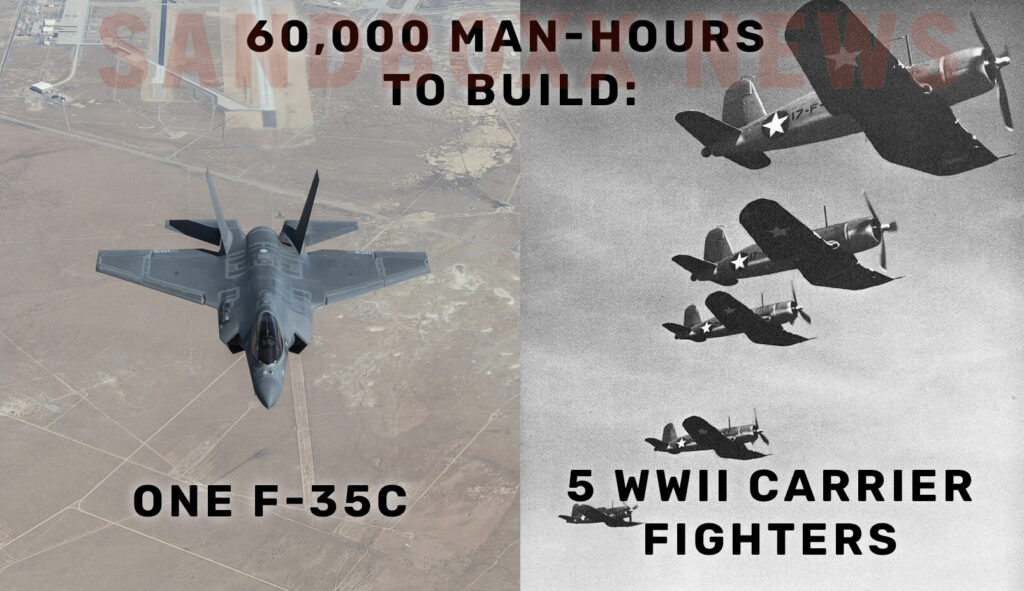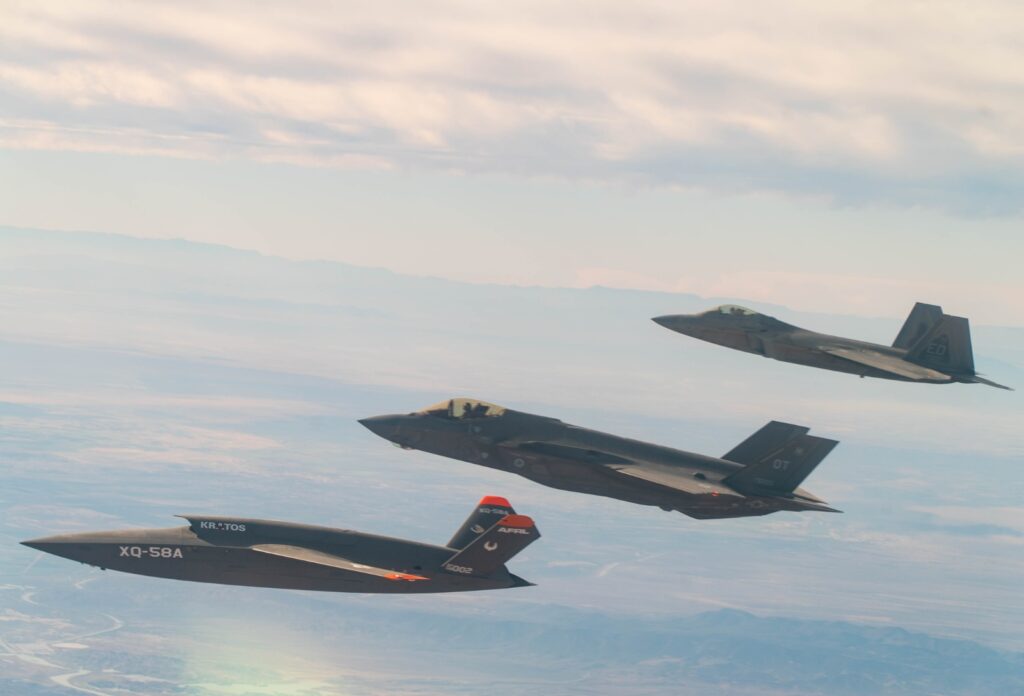In the not-too-distant future, the face of American airpower will dramatically shift away from a relatively few highly capable and crewed platforms and toward an overwhelming avalanche of unmanned systems, ranging from single-use munitions all the way to multi-million dollar multi-role UCAVs (Unmanned Combat Aerial Vehicles).
With new initiatives underway within the Pentagon to rapidly field thousands of drones the United States is now looking to return to the World War II methodology of peace through superior numbers. In order to do so, American Defense officials are aiming to push the boundaries of what we’ve commonly seen as science fiction, turning over vast portions of the warfighting enterprise to rapidly advancing, and often AI-enabled, robots.
Earlier this month, Deputy Secretary of Defense Kathleen Hicks announced the Pentagon’s Replicator Initiative, which aims to field “multiple thousands” of low-cost drones operating in air, land, and sea within the next two years, but remarkably, without requesting any additional funding. Instead of seeing this as a new program, Replicator might be better thought of as a new philosophy – steering the priorities of new acquisition efforts toward what the U.S. Air Force has long called, “affordable mass.”
“Replicator is not a new program of record,” Hicks explained. “We’re not creating a new bureaucracy and we will not be asking for new money in [fiscal 2024]. Not all problems need new money.”
While this concept seems to go hand in hand with the Air Force’s recent efforts to develop and field highly capable Collaborative Combat Aircraft (CCAs), or AI-enabled drones, to fly alongside its most advanced fighters into combat, Air Force Secretary Frank Kendall was quick to point out that CCA is not a part of the Replicator effort.
This is almost certainly because, as Hicks laid out, Replicator aims to field a large volume of inexpensive drones with a shelf life of just a few years each, whereas the Air Force’s CCA program aims to field extremely capable UCAVs with modular payloads and at least some degree of stealth. In other words, the CCA program is looking to field far more expensive platforms than Replicator, but the one thing these efforts have in common, of course, is a transition away from manpower as a measure of military might.
The truth is, despite the significant reach of the Replicator initiative, this transition is already well underway with or without it.
Related: Why today’s military AI isn’t capable of ‘going rogue’
The US military has been shrinking for decades

Despite America’s massive defense expenditures, the number of warships, fighter planes, and similar platforms in the U.S. arsenal has been steadily decreasing for decades now. This has come, in large part, thanks to rapid advances in a variety of technologies that allow fewer platforms to fill multiple roles. Nowhere is that more apparent than in the realm of tactical aircraft.
On the flight decks of America’s aircraft carriers, for instance, we’ve seen a rapid consolidation of airframes since the end of World War II, with specialized bombers, attack aircraft, reconnaissance platforms, and more being replaced by more broadly capable fighters. Even the Navy’s primary electronic attack aircraft today, the EA-18G Growler, is fundamentally a fighter as it shares an airframe with the F/A-18 Super Hornet and carries air-to-air missiles for self-defense.
America’s multi-role approach to air warfare has allowed it to focus on fielding some of the most advanced and broadly capable tactical aircraft ever to take to the skies, each equipped to fly a multitude of missions depending on operational requirements. There’s no denying this has been an extremely cost-effective approach to power projection throughout the asymmetric conflicts of recent decades, but in a high-end fight, it creates problems. No matter how multi-role your aircraft is, it can still only be in one place at one time… and with fewer platforms than ever, losing a single modern fighter represents a much more significant loss than in past eras.
As Marine aviator Dennis Santare and Navy veteran Chris Trost wrote for the Oliver Wyman consultancy earlier this year, “Superior technology is an advantage the United States military has historically leveraged to deter, fight, and win wars. But it’s not just advanced weaponry that has helped us fend off enemies. Our strength has also depended on our ability to mass combat power to overwhelm adversaries.”
Building a single F-35C, the carrier-capable iteration of the stealth fighter, requires a jaw-dropping 60,121 combined man-hours, according to a 2018 report from the Government Accountability Office. Conversely, it was reported during World War II that 20 carrier-capable F4U Corsair fighters could be built in 240,000 man-hours, which shakes out to approximately 12,000 man-hours per carrier fighter. In other words, takes approximately five times the man-hours to replace a modern carrier fighter than it would have 80 years ago.

By the end of World War II, the United States was operating nearly 300,000 military aircraft of all sorts, today, that number has dwindled to fewer than 14,000.
When you consider the broad range of capabilities delivered by America’s modern multi-role fighters, this disparity certainly makes sense, but that doesn’t change the problem this shift represents. America’s platforms may be incredibly capable, but they’re extremely expensive, hard to replace, and exist in too few numbers to withstand a large-scale conflict against a near-peer. And that’s before you consider the potential losses of aviators and crews, or longstanding concerns about readiness rates among America’s most advanced systems.
The solution, the Pentagon has assessed, is not a complete return to the old-school approach of rapidly fielding relatively inexpensive crewed aircraft and accepting that a large volume of those platforms, and their pilots, will be lost. Instead, Uncle Sam is now looking to a fusion of doctrines, combining even more modern and advanced platforms like the forthcoming Next Generation Air Dominance and F/A-XX fighters with a large volume of cheaper, more specialized drones that can be lost and replaced without overwhelming American budgets or production infrastructure.
Related: Why America’s new NGAD fighter could be a bargain, even at $300 million a piece
Inexpensive, ‘attritable’ airpower

The Air Force has been using the word attritable to describe platforms that are inexpensive enough to accept high levels of risk in combat for years now, seemingly intent on turning the hair of copy-editors the world over prematurely grey. But even if the word choices leave something to be desired, the concept itself could provide the United States with a massive leap in capability in both the short and long term.
This concept is embodied by platforms like the Kratos XQ-58A Valkyrie – a low-cost and low-observable UCAV that’s capable of carrying a 600-pound internal payload while flying at high-subsonic speeds at altitudes as high as 45,000 feet and to ranges as far as 3,000 nautical miles (around 3,450 miles). The capabilities the Valkyrie brings to bear are certainly potent, but its most impressive feat is its cost. The most capable top-of-the-line Valkyries are projected to cost just $6.5 million each, less than one hundredth the cost of a B-21 Raider and less than a tenth of the cost of an F-35.
In fact, a single XQ-58A Valkyrie costs only slightly more than a single AGM-88G anti-radiation missile used by American fighters to take out enemy air defense radar arrays. And, it goes without saying that missiles can only be used once. Kratos officials have gone on record to say that if orders exceed 50 airframes, costs may be reduced to as little as $4 million per Valkyrie, and if production runs to 100 airframes or more, the unit price could drop to just $2 million.

That would put these low observable UCAVs on a pretty equal financial footing with America’s current preferred form of kinetic diplomacy, the Tomahawk cruise missile.
“The category/class called ‘attritable aircraft’ really refers to an affordability objective solution to a UAV problem/need without an expectation for the aircraft to be in service forever. This class seeks an optimization of capability versus cost and life. It’s certainly not the intent to use these assets once and throw them away, but they are also not intended to remain in service for 100 years like the B-52 for example,” explained Steve Fendley, president of Kratos’ Unmanned Systems Division.
But as cost-effective as the Valkyrie may ultimately be, others will be far cheaper. Last year, for instance, it was announced that another Kratos drone, the MQM-178 Firejet-based Air Wolf, which started out as a target drone for air-to-air and surface-to-air missiles, is being tested for a wide variety of battlefield roles, including deploying Switchblade loitering munitions to expand sensor reach and engage targets on the drone’s behalf.
At just about $450,000 a piece, these low-cost UCAVs are launched via pneumatic catapult, giving them exceedingly small logistical footprints to be deployed from ground or even ship-based launchers.

Other efforts, like the X-61A Gremlin, are designed to be deployed and recovered by airborne cargo aircraft like the C-130 Hercules, but not everything about this new approach to affordable mass is reusable.
Related: Here are the 12 new stealth aircraft currently heading toward service
Blotting out the sun like Persian arrows
While much of the Defense Department’s focus is now on low-cost and reusable combat platforms, other efforts are focused on developing new methods of deploying existing munitions to reduce costs and deliver greater battlefield effect. And by effect, of course, I once again mean volume.
Chief among these efforts is the Air Force Research Lab’s Rapid Dragon program, which aims to allow cargo aircraft like the C-130 and C-17 to deploy dozens of long-range cruise and anti-ship missiles in a single volley. Rapid Dragon includes a modular palletized munition system that allows for stacks of six missiles per pallet in the C-130 and as many as nine per pallet in the larger C-17. These pallets were designed to accommodate the AGM-158 Joint Air to Surface Stand-off Missile (JASSM), but it stands to reason that they can deploy the longer-ranged JASMM-ER as well as the AGM-158C Long Range Anti-Ship Missile as well, as they share the exact same exterior dimensions.
The pallets are rolled out the back of the aircraft like any other airdrop. Once deployed, a parachute opens to stabilize the pallet as the onboard control system fires the missiles to begin their trek of more than 500 miles (and potentially greater than 1,000) to their targets where they will deliver 1,100-pound explosive warheads to land or sea targets.
Last December, U.S. Air Force A-10 Thunderbolt IIs, often seen as a relic of a bygone era, began training to support this new approach to overwhelming enemy air defenses through chaotic volume by incorporating ADM-160 Miniature Air Launched Decoys (MALDs) into their arsenals. The A-10 can be fitted with as many as 16 of these handy decoys, which puts it on par with the much larger B-52 Stratofortress.
The nine-foot-long, 300-pound MALD looks like a missile, but instead of an explosive payload, it carries a Signature Augmentation Subsystem (SAS) that can broadcast the radar return of any aircraft in the U.S. arsenal to spoof enemy air defenses into targeting the MALD instead of nearby missiles or aircraft. The latest in-service iterations, the ADM-160C MALD-J, also include a modular electronic warfare capability developed under the name CERBERUS. Much more than a single radar jammer, CERBERUS offers a variety of interchangeable electronic warfare (EW) payloads that can be swapped in and out in less than a minute, allowing for tailored EW attacks for a variety of battlefield conditions.

In other words, the small and expendable MALD-J is capable of fooling enemy air defenses into thinking they’re all sorts of incoming aircraft, and can also jam early warning and targeting radar arrays to further complicate matters for defending forces.
With a range in excess of 500 miles and a new, even more capable iteration (known as the MALD-X) in development, these air-launched decoys can significantly bolster the efficacy of other aircraft and weapon systems. And at around $322,000 a piece, these systems are inexpensive enough to be leveraged in great numbers without breaking the bank.
As just one hypothetical use-case, these two efforts alone would allow a very small number of A-10s and cargo aircraft like the C-17 to deploy a massive amount of decoys, jammers, and firepower in the event of a Chinese invasion of Taiwan. As Chinese warships attempted to ferry troops across 100 miles of the Taiwan Strait, a fleet of just four C-17s and four more A-10s could lob 64 jamming decoys and 180 long-range anti-ship missiles from 500 miles away, overwhelming air defenses and wreaking havoc on the Chinese fleet before a single fighter, bomber, or done has even flown a sortie.
Related: Images surface of secretive US MALD flying decoy used in Ukraine
If it’s not cheap, it better be modular

Of course, all of this focus on low-cost volume doesn’t change America’s affinity for advanced (and supremely expensive) platforms, and even this shift toward advanced drones can’t change that. Some of the most expensive uncrewed platforms to emerge in the coming years will almost certainly evolve out of today’s Combat Collaborative Aircraft (CCA) efforts to field AI-enabled drone wingmen to fly alongside America’s top-tier fighters.
These drones will carry a variety of payloads and take their cues from advanced fighters like the Air Force’s Next Generation Air Dominance fighter, the Navy’s F/A-XX fighter, and the forthcoming Block 4 F-35. These drones will extend the sensor reach of their crewed fighters by flying out ahead, carrying electronic warfare equipment to jam enemy defenses, deploying air-to-ground and even air-to-air munitions on behalf of the crewed fighter and more – effectively turning every one piloted fighter into an entire formation unto themselves.
A number of firms are currently competing for a piece of the CCA enterprise and many of these efforts remain shrouded in a veil of secrecy, but one program that has been revealed to the public that we can use as an example is Boeing’s Australia-led MQ-28 Ghost Bat. This 38-foot UCAV operates like any other fighter and offers a range of more than 2,000 nautical miles (more than 2,300 miles).

Like other CCA platforms, the MQ-28 is designed to accommodate and rapidly swap out modular payloads, allowing the aircraft to serve in a variety of rules with a very short turnaround. This ability can give commanders in-theater more flexibility in deciding how best to leverage the UCAVs, but more importantly, it will also allow for rapid updates and upgrades as new technologies emerge.
Arguably, the most important part of this endeavor is the artificial intelligence required to operate these aircraft. The U.S. Air Force is already hard at work developing multiple AI Agents (as they’re called) for this role, with one specially modified F-16, dubbed the X-62A, completing its first air combat exercises with AI in control last December. This year, six additional and fully combat-coded F-16s are being modified to accommodate AI pilots as part of the Air Force’s Project VENOM to further mature the concept.
These AI-enabled F-16s will fly in a variety of exercises and combat simulations with human pilots onboard, so the artificial intelligence can learn directly from human operators how best to manage aviation tasks with increased complexity, culminating in what will eventually be nearly autonomous platforms that can execute complex orders as delivered by a human operator in a nearby stealth fighter.
Related: This is what it takes to join military aviation’s most exclusive club
The future may be about drones, but pilots aren’t going anywhere

Despite rapid advances in AI and automation, as well as the Pentagon’s renewed focus on low-cost combat drones, human pilots will still play an integral role in American air combat operations for years to come. Even the most advanced AI-enabled platforms are still being designed to be effectively operated by human pilots in nearby fighters. Rather than thinking of these drones as autonomous warfighters, it might be more apt to think of them in the same way we might think of a sensor pod carried underwing. Ultimately, these programs, systems, and platforms are being designed to serve as weapons in the hands of the modern warfighter, rather than as replacements for the warfighters themselves.
But while the United States has long used technology as a force multiplier, these new efforts will finally allow for the use of that term in a very literal sense.
To return to the World War II comparison, aircraft of that era may have required fewer man-hours to build… but a single B-29 Super Fortress required a crew of 10-14 to operate. In the not-too-distant future, that ratio will be turned on its head, with just one or two human operators controlling five, 10, or even more platforms simultaneously.
Read more from Sandboxx News
- Ukraine’s counteroffensive is making some progress but it can’t afford to halt
- The Lethality System Project takes the Australian military’s small arms to the future
- The Marine Corps is not struggling with recruiting and this may be due to its unique nature
- Army pauses retention cash bonuses amid sky-high reenlistment rate
- Incredible mortar-assembly challenges with the Green Berets


